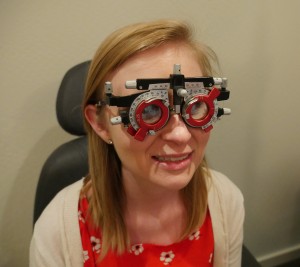
A child’s eye health may be easy to overlook, but preventative care can have a lifelong impact. Photo: American Ratings Corporation (2016)
with Dr. Thomas Aller, president of Dr. Thomas A. Aller Optometrist, Inc.
Hygiene, nutrition, physical safety, emotional well-being…there are a lot of things to think about when raising young children, which is why parents often find themselves prioritizing immediate concerns over less pressing ones. One common instance of the latter is eye health—after all, except for severe instances, vision problems are rarely ostensibly apparent, which makes it easy for them to go unnoticed. However, the furtive character of such problems makes it all the more crucial for parents to give some foresight to their children’s optical health.
Dr. Thomas Aller, president of Dr. Thomas A. Aller Optometrist, Inc., says that when vision problems are treated early, they can be alleviated and, in some cases, corrected altogether. The most compelling example of this (as far as young children are concerned) is farsightedness, which is a difficulty seeing things up close. “Farsightedness can occur in a couple of different forms, but either one can result in problems like double vision from eye crossing and amblyopia, which is more commonly known as ‘lazy eye,’” explains Dr. Aller. “These conditions can be 100 percent prevented by early treatment, which is why a four-, three- or even two-year-old may benefit from wearing glasses.”
While it rarely shows up as early as farsightedness, another eye condition parents need to be aware of is nearsightedness. “Nearsightedness isn’t simply an annoyance that requires glasses for distant vision—it’s an abnormal condition whereby the eye actually elongates over time while simultaneously causing the retina to become thinner,” says Dr. Aller. “Because of its progressive nature, people who start to develop nearsightedness early in life are likely to have more severe symptoms as they get older.” While nearsightedness has long been considered an untreatable condition, Dr. Aller says scientific research has produced techniques to both delay its onset and diminish its long-term consequences. “Today, there are special eyeglasses that can help slow the progression of nearsightedness, as well as eye drop and contact lens treatments that can dramatically reduce its effects later in life. The earlier children are started on these interventions, the better the final outcome will be.”
As if the physical symptoms weren’t bad enough, Dr. Aller says an eye condition can also impact a child’s intellectual development. “When children are unable to see well, it hinders their learning ability and enthusiasm. For example, if reading is unenjoyable due to eye strain, a child may become less interested and even resistant to it. Additionally, children who have difficulty seeing the front of the classroom also tend to have difficulty keeping up with the lesson. What’s worse, children often have trouble verbalizing their vision problems, so it’s crucial for parents to observe their children and heed the signs.”

Regardless of one’s age, professional eye exams are a cornerstone of proactive care. Photo: American Ratings Corporation (2016)
In order to treat eye problems preventatively, Dr. Aller recommends annual eye examinations, which give an optometrist the chance to spot developments early. Additionally, he offers a couple of practical tips to promote healthy vision. “Studies indicate that the more time young children spend outdoors, the less likely they are to develop nearsightedness or myopia, so make sure to get your kids out of the house on a regular basis,” he says. “Furthermore, when it comes to eye health, one of the best practices you can instill in your child is proper handwashing. Kids’ fingers touch all sorts of things, and when they rub their eyes, it’s easy for germs to get transmitted, so frequent handwashing will help prevent related problems.”
In the course of caring for your child’s eyes, you may find out they need glasses, which entails a whole other set of considerations. In this case, check out our follow-up article, “Five Considerations for Buying Your Child Glasses.” Meanwhile, to find a Diamond Certified optometrist or ophthalmologist, visit www.diamondcertified.info.
